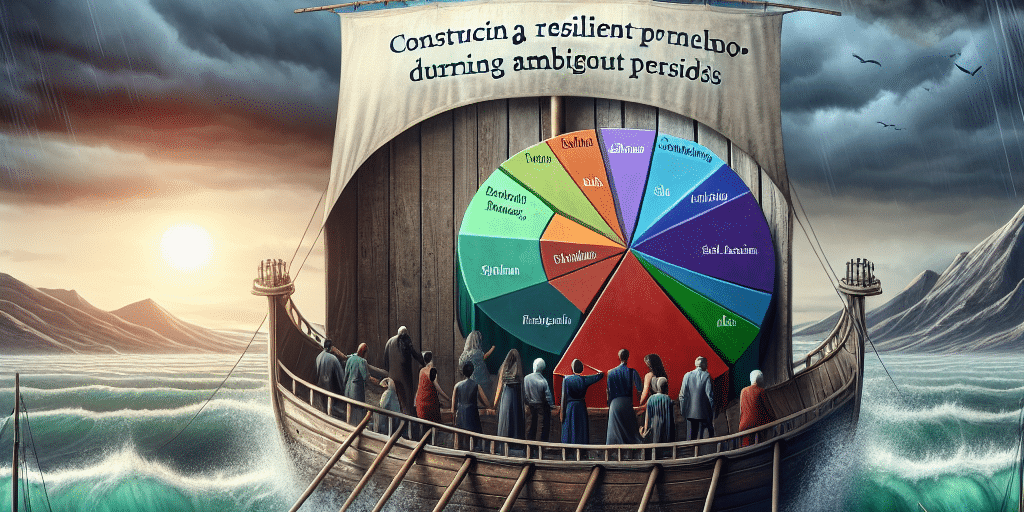Title: Building a Resilient Portfolio in Uncertain Times: Strategies for Financial Stability
In today’s ever-changing economic landscape, uncertainty is perhaps the only certainty. Global events, market volatility, and unforeseen challenges can all impact investment portfolios, leaving investors seeking stability amidst the storm. Building a resilient portfolio during uncertain times is not just a strategy but a necessity to safeguard financial health. Here’s a guide on how to navigate this complex task.
1. Diversification: The Cornerstone of Resilience
Diversification is a fundamental principle in creating a strong portfolio. By spreading investments across different asset classes—such as stocks, bonds, real estate, and commodities—you reduce the risk of any single investment adversely affecting the overall portfolio. This strategy allows for potential gains in some areas to offset losses in others.
- Equities: Include a mix of domestic and international stocks, focusing on various sectors. Consider dividend-paying stocks for income generation and growth stocks for capital appreciation.
- Bonds: Incorporate a blend of government, municipal, and corporate bonds. Bonds tend to provide stability and can act as a buffer during stock market downturns.
- Alternative Investments: Explore investment in real estate, commodities like gold, or funds such as REITs. These can offer further diversification and a hedge against inflation.
2. Risk Assessment and Management
Understanding one’s risk tolerance is critical. This involves assessing how much risk you can handle both financially and emotionally. Risk tolerance can guide asset allocation decisions, influencing the balance between higher-risk investments like equities and safer bets such as bonds.
- Risk Profiling: Regularly assess your risk profile, considering age, income level, investment goals, and time horizon.
- Stop-Loss Orders: Implement stop-loss orders to limit potential losses on stocks.
- Rebalancing: Periodically rebalance your portfolio to maintain your risk level, trimming winners, and bolstering underperformers as necessary.
3. Emergency Funds and Cash Reserves
In uncertain times, liquidity can be a lifeline. Having a well-stocked emergency fund ensures you don’t need to liquidate investments at inopportune moments.
- Cash Reserve: Maintain a cash reserve to cover at least three to six months of living expenses.
- Liquid Investments: Include short-term securities or money market funds for additional liquidity.
4. Invest in Defensive Stocks
Defensive stocks are those of companies providing essential goods and services—such as utilities, healthcare, and consumer staples—that tend to withstand economic downturns.
- Utility Stocks: Companies in the utility sector often provide stable returns due to ongoing demand for their products.
- Healthcare Sector: Healthcare is less sensitive to economic cycles, making it a reliable sector for investment.
- Consumer Staples: Products like food, beverages, and household goods are always in demand, regardless of the economic environment.
5. Focus on Quality and Fundamentals
During turbulent times, prioritize investments in companies with strong fundamentals—those with solid balance sheets, consistent earnings, and reliable cash flow.
- Blue-Chip Stocks: Consider investments in blue-chip companies with a history of stability and dividend payments.
- Quality Bonds: Opt for high-rated bonds to mitigate credit risk.
6. Keep an Eye on Emerging Trends
While safeguarding your existing assets, remain open to new opportunities that arise from changing conditions. Technological advancements, shifts in consumer behavior, and sustainability trends may present new avenues for growth.
7. Continuous Education and Advice
Staying informed and educated about market trends, emerging risks, and economic forecasts is vital. Consider consulting with a financial advisor to make informed adjustments to your portfolio.
8. Patience and Discipline
Emotional decision-making can significantly harm your long-term financial success. During volatile times, it’s important to remain patient and disciplined, focusing on your long-term financial goals instead of short-term market movements.
Conclusion
Creating a resilient portfolio during uncertain times requires a thoughtful approach that balances risk and reward. By diversifying investments, assessing risks, maintaining liquidity, and focusing on quality, investors can position themselves to weather economic storms and achieve financial stability. While uncertainty is unavoidable, a well-structured portfolio can offer peace of mind and potential growth, no matter what the future holds.







